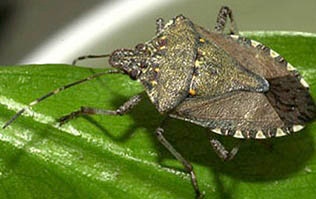
Another new pest has arrived on the scene that has the potential to blow IPM programs out of the water, at least initially.The brown marmorated stink bug (BMSB) is not only a huge threat to California agriculture, but is also a nightmarish nuisance pest, gathering in buildings and around outdoor lights in such numbers that manure shovels and 5-gallon buckets are required to dispose of them. The insect has a strong, unpleasant odor when disturbed.
January 10, 2011

Another new pest has arrived on the scene that has the potential to blow IPM programs out of the water, at least initially. The brown marmorated stink bug (BMSB) is not only a huge threat to California agriculture, but is also a nightmarish nuisance pest, gathering in buildings and around outdoor lights in such numbers that manure shovels and 5-gallon buckets are required to dispose of them. The insect has a strong, unpleasant odor when disturbed.
I recently attended a talk at UC Davis by Tracy Leskey, USDA Research Entomologist in West Virginia, who has focused on this pest in the last two years; this article is mostly based on that talk.
Origin and spread. BMSB is native to East Asia, where it is a pest but is kept under fairly good control by natural enemies. Pests often arrive in the US without their natural enemies, so populations are initially very high until sometimes being brought under control by introduced natural enemies. However, conditions may not always be as conducive for the natural enemies, and the presence of many more crop species in California may give pests a wider host range.
The pest was identified in Pennsylvania in 2001, and began causing widespread crop damage in 2009. It has now been found in 29 states, and is resident in Oregon from Portland south to Corvallis and east to Hood River. It has been present in Los Angeles since 2005, and it was intercepted by CDFA in a storage facility in Vallejo, Calif., in 2005. The pest is an excellent hitchhiker, transferring to other areas very easily. It may have been introduced to the US by way of cargo shipments from Asia.
Characteristics. The name “marmorated” is from the Latin word for marble, “marmor”; the back of the adult has a marble-like pattern. It can be identified by the white bands on antennae and legs. Also, the mouthparts extend beyond the third pair of legs. BMSB has up to six generations per year, although in West Virginia there are only two. It has large overwintering populations, even in cold climates.
Crop hosts. The many hosts of BMSB include tree fruits including apples, pears, and cherries; small fruits including grapes, and fruiting vegetables including corn, tomatoes, peppers, and legumes. Both adults and nymphs feed on immature and ripening fruit, causing cat-facing on the surface and internal injury. In 2010, apple and peach orchards have sustained 50 percent to 70 percent damage, with a large number of orchards having complete crop loss. In some cases, fruit has gone into cold storage apparently healthy but injury develops in storage. BMSB moves into crops from adjacent areas, but unlike most stink bugs, it is able to reproduce within the orchard as well.
In grapes, berries collapse and rot increases, and tasters have been able to detect stink but odor in wines with 10 bugs in a “lug” of grapes. BMSB has also done severe damage to ornamentals and nursery crops, feeding through the bark of young trunks.
Monitoring and insecticides
Monitoring. No truly effective monitoring tools have been developed yet. Tall, baited pyramid traps placed on the ground are used for capture, and black and dark green have been found to be the most attractive to BMSB, probably because they resemble a tree trunk.
These traps catch far more than standard Asian traps placed in the canopy. The standard bait used is methyl decatrienoate, and whereas 50 mg lures are typical for standard stink bugs, trap catches increased up to 450 mg. Average catches of over 400 adults/trap/week were recorded; one trap had over 1,500.Because trap counts greatly increase late in the season, there is potential for attract and kill or mass-trapping strategies in late summer.
There is also potential monitoring with light and pheromones, as the aggregation pheromone has been identified.
Insecticides typically used for stink bug control are may not work as well on BMSB. In lab and field tests, Dr. Leskey has found that several neonicotinoids and pyrethroids knock down and paralyze adults but then they recover in the days following treatment. In lab tests, only the OP Lannate (methomyl) provided high mortality, and the pyrethroid Danitol (fenpropathrin) had 50 percent mortality. She also found that mortality of these products dropped dramatically when adults were subjected to treated and dried foliage. Since there is constant movement from adjacent areas, residual pesticide will be required for effectiveness. However, repeated use of such pesticides would kill beneficials and affect IPM programs.
You May Also Like



